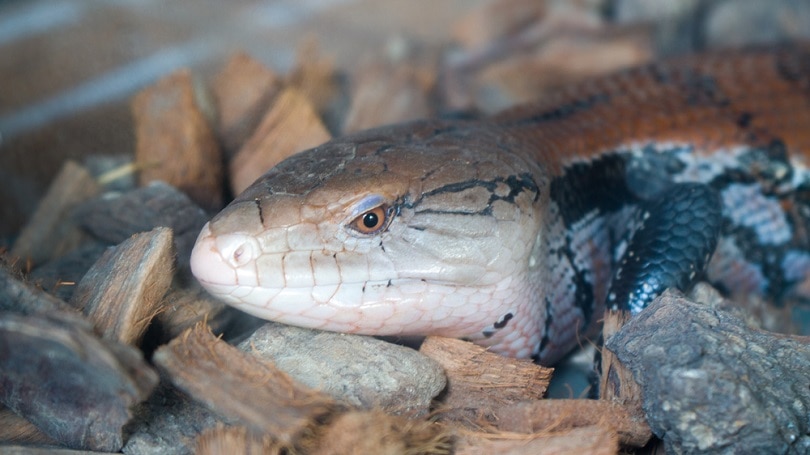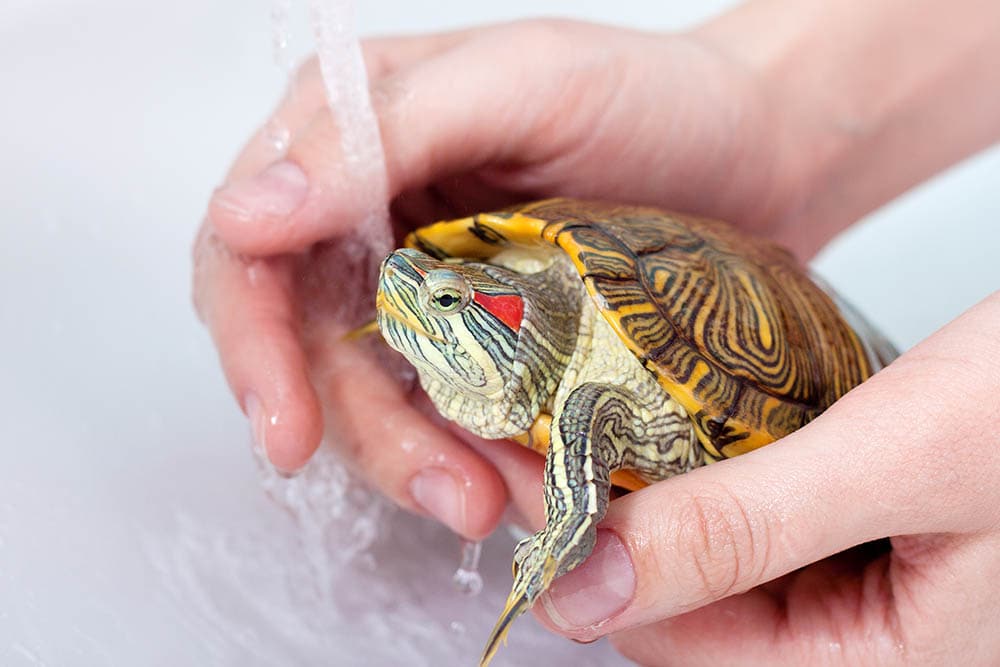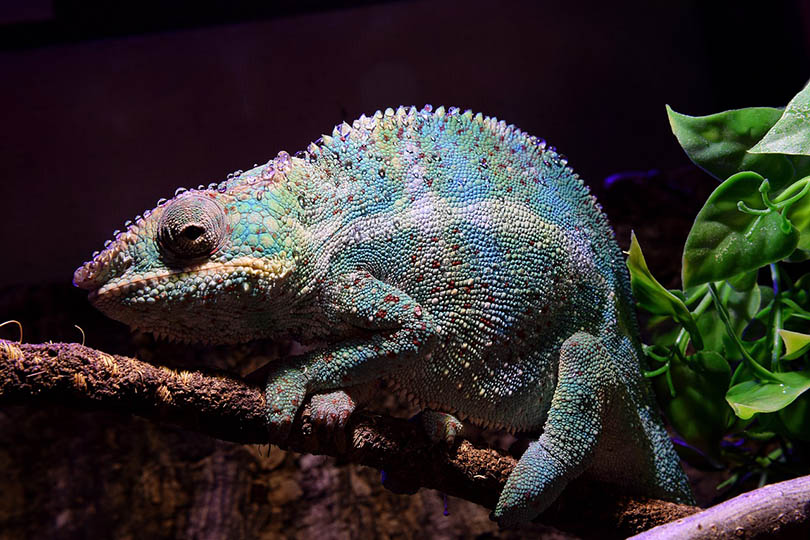
Blue Tongue Skinks are friendly, intelligent reptiles in general, and since they are easy to care for and low-maintenance animals, they make great pets overall. They are fairly easy to train and enjoy being handled, making them great reptile pets for novice owners too. They are not as popular as other reptile pets, like snakes and geckos, but are steadily growing in popularity.
The Merauke Blue Tongue Skink, also known as the Giant Blue Tongue Skink, is the longest of the Skink species and is native to Indonesia and Papua New Guinea. While they are not as visually striking as many other Skink species, their large size is making them gradually gain in popularity in the pet trade. While they are readily found in the wild, they are somewhat difficult to find in captivity, although breeding programs are slowly being established.
Read on to find out more about this uniquely large pet lizard!
Quick Facts About Merauke Blue Tongue Skink
| Species Name: | Tiliqua gigas evanescens |
| Common Name: | Blue Tongue Skink, Giant Blue Tongue Skink |
| Care Level: | Easy |
| Lifespan: | 15–20 years |
| Adult Size: | 26–30 inches |
| Diet: | Omnivore |
| Minimum Tank Size: | 60 gallons |
| Temperature & Humidity: | 75–82 degrees Fahrenheit on the cool side, 90–100 degrees Fahrenheit basking spot
60-80% humidity |
Do Merauke Blue Tongue Skinks Make Good Pets?
Due to their docile, friendly temperament and ease of training, Blue-Tongue Skinks make great pets in general. They are also easy to care for and low maintenance, so they are ideal reptiles for beginners and novice owners alike. That said, the Merauke is the largest of the Blue Tongue Skink species and requires slightly larger housing and is more difficult to handle than other Skinks. They are difficult to find because not many are bred in captivity. Most, if not all, captive Meraukes are wild-caught, and this is largely why these lizards are not commonly kept as pets.

Appearance
Merauke Skinks are hefty, large lizards that can easily reach up to 30 inches long as adults due to their massive tail length. Adult Merauke Skinks are usually slate grey in color with distinct thin grey or light brown bands along the length of their bodies and a light orange belly. Some may have red freckling between these bands, although most do not. The limbs tend to be almost completely black, and their heads are usually paler and devoid of markings. Their scientific name “evanescens” means to fade or lighten, and as these Skinks get older, their coloring tends to fade slightly.
How to Take Care of Merauke Blue Tongue Skink
Caring for a Merauke Skink is much the same as any other Skink species, although you’ll need to cater to their long tail! These reptiles are native to Indonesia, a relatively hot and humid climate, and you’ll want to match these conditions as closely as possible.
Tank
Your Merauke Skink will need a large enclosure of at least 50–60 gallons, although larger is even better because they are fairly active creatures. PVC is the best material because it is waterproof and lightweight, but glass is suitable too. An enclosure that opens from the front rather than the top is far more convenient, as this will allow you to spot-clean the tank easily, which you should do every day or two.
Lighting
Since Skinks are diurnal, meaning they are most active during the day, they’ll need lighting that mimics a normal day/night cycle. UVB lights are best because they will help your Skink create the vitamin D that their body needs and help keep the enclosure free of pathogens.

Heating (Temperature & Humidity)
Skinks need a temperature gradient inside their enclosure to help them thermoregulate (cool down and heat up) as needed. This is best achieved with under-tank heating and a ceramic heat lamp placed on one side of their enclosure, with a large rock for them to bask on. You’ll need a temperature gradient of around 75–82 degrees Fahrenheit on the cool side and 90–100 degrees Fahrenheit on the basking spot.
Humidity can be easily maintained by gently misting your Skink’s enclosure every day with a misting bottle. They’ll need a relative humidity of 60–80%, which should be monitored with a hygrometer.
Substrate
Skinks like to burrow, so they need a fairly deep substrate of at least 4–6 inches. Aspen wood shavings, coconut husk, cypress mulch, or even clean soil make great substrates for your Skink, but reptile bark bedding is arguably the best option because it has the ability to absorb moisture and release it into the enclosure, which is ideal for humidity-loving Merauke Skinks.
| Tank Recommendations | |
| Tank Type: | 60-gallon PVC or glass vivarium |
| Lighting: | UVB lighting |
| Heating: | Heating pad/tape on the bottom of enclosure and a ceramic heat lamp |
| Best Substrate: | Reptile bark bedding |
Feeding Your Merauke Blue Tongue Skink
Merauke Skinks are omnivores and need both plants and animals in their diet to stay healthy. They’ll need more animal protein in their diet as they grow — around 70–80% total — and this can be reduced to around 50–60% animal protein after the first two years. The key to a healthy Skink is giving them as large a variety in their diet as possible. Animal foods can include small frozen rodents, pinkies, insects, and mealworms, along with a high-quality dog or cat food occasionally too.
There are various plant foods that Skinks will enjoy, including dandelion greens, collard greens, carrots, squash, shredded leafy greens, and fruits like bananas, mangoes, and strawberries. You can give your Skink calcium and vitamin powders to ensure that they are getting all the vitamins and minerals that they need, although not too often — once or twice a week is ideal for calcium and once a week for multivitamins.
| Diet Summary | |
| Fruits and vegetables: | 40–50% of diet (adults) |
| Meat: | 50-60% of diet: small rodents, insects, dog and cat food |
| Supplements Required: | Calcium and multivitamin supplements |

Keeping Your Merauke Blue Tongue Skink Healthy
Diet is one of the most important aspects of keeping your Skink healthy, but a clean, spacious enclosure is also vital. Be careful to not overfeed your Skink, and if there is food left over after meals, you are likely feeding them too much. Also, you should never keep two Skinks in the same cage together because they can be territorial and will likely end up fighting.
Common Health Issues
One of the most common health issues with Skinks is metabolic bone disease, caused by an out-of-balance calcium-to-phosphorus ratio. This will cause their bones to become weakened and easily fractured and cause overall lethargy. Another common problem is shedding issues caused by a lack of humidity. All lizards shed their skins, and if your Skink is having trouble shedding, there is likely a humidity issue in their enclosure.
Lifespan
With the proper care and a healthy, nutritious diet, Merauke Skinks can easily live for up to 20 years in captivity and even longer in some cases. These lizards grow surprisingly rapidly, reaching sexual maturity at 18–24 months, after which their growth slows down significantly.
Breeding
No matter the species of Blue Tongue Skink, captive breeding is challenging, although some species are easier than others. Most, if not all, captive Merauke Skinks are wild caught because their breeding in captivity is so challenging, although many breeders have begun to take up the challenge.
Blue Tongue Skinks can be violent while breeding, and females can get aggressive and defensive toward males if they are not ready, which can easily result in injury. Even babies can hurt each other if left alone. Skinks do give birth to live young, though, which negates the need to incubate eggs.
Are Merauke Blue Tongue Skinks Friendly? Our Handling Advice
Merauke Skinks are generally docile lizards that tolerate handling well, but you’ll need to train them first. We recommend waiting at least 2 weeks after you bring your Skink home before attempting to handle them, as this will give them time to settle in. In the meantime, you can let them get comfortable with your scent and voice and even let your hand rest inside their enclosure. Once they seem calm in your presence and do not run away from you, you can begin to handle them, but keep sessions short at first. Trust can take a while to build with your Skink, and patience is key.
Shedding & Brumation: What to Expect
Like all lizards, Skinks shed their skin regularly. Young Skinks will shed as much as every 2 weeks, while adults typically shed once every 2 to 3 months. Never handle your Skink while they are shedding, which typically lasts a week, and don’t be alarmed if they eat less or not at all during this time, as it is perfectly normal.
In the wild, adult Skinks will brumate for up to 4 months of the year, where they eat and drink very little and sleep almost constantly. Most reptiles, including Skinks, do not need to bromate in captivity, but many experts recommend it for long-term health. This is typically induced by a reduction in light and heat and reduced feeding.
How Much Do Merauke Blue Tongue Skinks Cost?
Skinks are expensive to purchase in general, and rare species such as the Merauke are more so. They can go for around $300, depending on availability, and that’s if you can find one for sale. You’ll also need to factor in the initial setup costs for a tank, heater, and accessories. Budget another $40–$60 a month for food and maintenance.

Care Guide Summary
- Related Read: 7 Types of Skinks That Make Great Pets
Summary
The Merauke Blue Tongue Skink is a rare lizard, the largest of all Skinks and one of the most docile too. These large lizards can make great pets — if you are lucky enough to find one. They’ll need larger-than-average enclosures to account for their long tails. They may not be the most visually striking Skink but are beautiful nonetheless, and their large size makes them one of the most exotic and unique varieties around!
See also:
Featured Image Credit: dwi putra stock, Shutterstock










